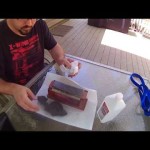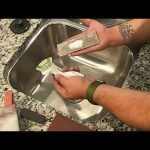
d77156ec71c5151428459be3bec15498
Stainless steel knives are a kitchen staple, but they can easily become rusty if not properly cared for. Rust can make your knives look dull and unappealing, and can even make them unsafe to use. Fortunately, it’s easy to clean rust off stainless steel knives with a few simple steps. In this article, we’ll provide a step-by-step guide on how to clean rust off stainless steel knives, so you can keep your knives looking and performing their best.
How do you get rust off stainless steel knives
Stainless steel knives are a great kitchen tool, but they can be prone to rusting if not properly cared for. Rust can be unsightly and can even affect the performance of your knife. Fortunately, there are a few simple methods you can use to remove rust from your stainless steel knives.
Using White Vinegar
White vinegar is a great natural rust remover. To use it, simply soak a cloth in white vinegar and rub it onto the rusty area of the knife. You may need to repeat this process several times to completely remove the rust. Once the rust is gone, rinse the knife with warm water and dry it thoroughly.
Using Baking Soda
Baking soda is another natural rust remover. To use it, mix baking soda with a small amount of water to form a paste. Apply the paste to the rusty area of the knife and let it sit for a few minutes. Then, use a soft cloth to scrub the paste off the knife. Rinse the knife with warm water and dry it thoroughly.
Using Steel Wool
If the rust is particularly stubborn, you may need to use steel wool. To do this, dampen a piece of steel wool and rub it gently over the rusty area of the knife. Be sure to use a light touch, as steel wool can scratch the surface of the knife. Once the rust is gone, rinse the knife with warm water and dry it thoroughly.
Preventing Rust
The best way to keep your stainless steel knives rust-free is to take proper care of them. After each use, be sure to rinse the knife with warm water and dry it thoroughly. You should also store your knives in a dry place, away from moisture. If you follow these simple steps, your knives should stay rust-free for years to come.
What kills rust on stainless steel
Stainless steel is a popular material for many applications due to its strength and durability. However, it is not immune to rust. Rust can form on stainless steel when it is exposed to moisture and oxygen. Fortunately, there are several methods that can be used to remove rust from stainless steel and prevent it from forming again.
Using Chemical Rust Removers
Chemical rust removers are one of the most effective ways to remove rust from stainless steel. These products contain chemicals that react with the rust and dissolve it. They are available in both liquid and gel form and can be applied directly to the affected area. After the rust has been removed, it is important to rinse the area with water and dry it thoroughly to prevent further rusting.
Using a Wire Brush
A wire brush can be used to scrub away rust from stainless steel. It is important to use a brush made of stainless steel or another non-corrosive material to avoid damaging the surface. The brush should be used in a circular motion to remove the rust. Once the rust has been removed, the area should be rinsed with water and dried thoroughly.
Using Sandpaper
Sandpaper can also be used to remove rust from stainless steel. It is important to use a grit that is appropriate for the surface. Coarse grits should be used for heavier rust, while finer grits should be used for lighter rust. The sandpaper should be used in a circular motion to remove the rust. Once the rust has been removed, the area should be rinsed with water and dried thoroughly.
Preventing Rust
Once the rust has been removed from stainless steel, it is important to take steps to prevent it from forming again. The surface should be cleaned regularly with a mild detergent and water.
It is also important to keep the surface dry and free of moisture. If the stainless steel is exposed to salt water or other corrosive substances, it should be rinsed with fresh water and dried immediately.
Rust on stainless steel can be removed and prevented with the right methods. Chemical rust removers, wire brushes, and sandpaper can all be used to remove rust. It is also important to take steps to prevent rust from forming again, such as cleaning the surface regularly and keeping it dry.
How do you remove rust and oxidation from stainless steel
Stainless steel is a popular material for many applications due to its durability and corrosion resistance. However, it is not immune to rust and oxidation. Fortunately, there are several methods for removing rust and oxidation from stainless steel.
Using a Cleaning Agent
One of the most common methods for removing rust and oxidation from stainless steel is to use a cleaning agent. White vinegar is a popular choice, as it is a natural cleaning agent that is safe to use on stainless steel. To use white vinegar, simply soak a cloth in the vinegar and use it to scrub the affected area. You can also use a commercial rust remover if you prefer.
Using a Wire Brush
Another method for removing rust and oxidation from stainless steel is to use a wire brush. This method is best used for small areas of rust and oxidation. To use a wire brush, simply scrub the affected area with the brush until the rust and oxidation are removed. Be sure to wear protective gloves and safety glasses when using a wire brush.
Using a Sander
If the rust and oxidation are more extensive, you may need to use a sander. This method is best used for larger areas of rust and oxidation. To use a sander, simply attach a sanding disc to the sander and use it to sand the affected area. Be sure to wear protective gloves and safety glasses when using a sander.
Conclusion
Removing rust and oxidation from stainless steel can be a difficult task, but it is possible. The best method for removing rust and oxidation will depend on the size and severity of the affected area. Using a cleaning agent, wire brush, or sander are all effective methods for removing rust and oxidation from stainless steel.
What cleaner to use on stainless steel knives
Stainless steel knives are a popular choice for many kitchens due to their durability and ease of maintenance. However, it is important to use the right cleaner to ensure that your knives stay in top condition. Here are some tips on what cleaner to use on stainless steel knives.
Cleaning with Soap and Water
The simplest and most effective way to clean stainless steel knives is to use a mild soap and warm water. This will remove any dirt and debris from the blade and handle. Make sure to rinse the knife thoroughly after cleaning to remove any soap residue. Dish soap is a great choice for this type of cleaning.
Using a Stainless Steel Cleaner
If you want to give your knives a deeper clean, you can use a stainless steel cleaner. These cleaners are specifically designed to remove grease, fingerprints, and other residue from stainless steel surfaces. Make sure to follow the instructions on the cleaner carefully and rinse the knife thoroughly after use.
Using a Non-Abrasive Cleaner
If you want to avoid using a stainless steel cleaner, you can use a non-abrasive cleaner such as baking soda or vinegar. These cleaners are gentle enough to use on stainless steel surfaces without damaging them. Simply mix the cleaner with water to create a paste and use a soft cloth to apply it to the knife. Rinse the knife thoroughly after use.
Conclusion
Cleaning your stainless steel knives is an important part of keeping them in top condition. The best way to clean them is to use a mild soap and warm water, but you can also use a stainless steel cleaner or a non-abrasive cleaner such as baking soda or vinegar. Make sure to rinse the knife thoroughly after cleaning to remove any residue.
We hope this guide has been helpful in teaching you how to clean rust off stainless steel knives. With the right tools and a bit of patience, you can have your knives looking like new in no time. Goodbye and good luck!








